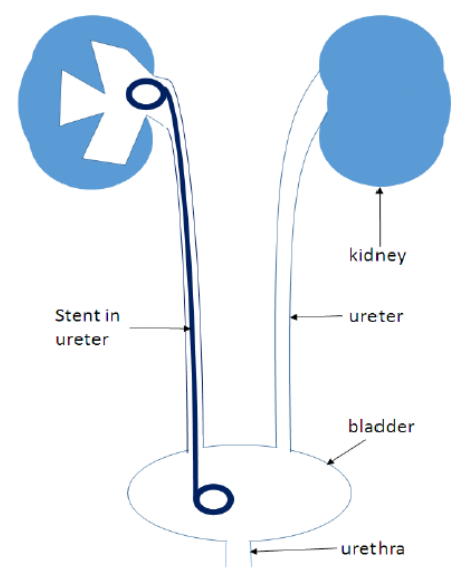Ureteric Stent Insertion
This information leaflet has been developed to provide patients with post-operative advice following ureteric stent insertion.
A ureter is a tube which drains urine from your kidney into the bladder. You have undergone a procedure to insert a ureteric stent, which is a thin flexible tube that is inserted into the ureter with loops at either end to keep it secured. One loop stays in your kidney, while the other one resides inside the bladder preventing migration (movement). Some stents have a thread attached to the lower end which hangs outside your urethra (urine passage) and is taped to your body. This type of stent is normally inserted when needed for only a short duration.

Stents are usually inserted because either your doctor has discovered an obstruction in your kidney, or before lithotripsy is undertaken (lithotripsy is a procedure that breaks up kidney/ureteric stones with ultrasound shockwaves) or after inspection of your ureter with a camera. An operation to insert a ureteric stent is performed to either relieve or prevent kidney blockage (also called an obstruction) by keeping the ureter open so that urine can easily flow from the kidney to the bladder.
What should you expect?
After the operation you may experience any of the following symptoms:
- Back pain towards the side with stent, especially when you pass urine with pain in the bladder area
- Blood in the urine, increased frequency and urgency of urination
- Pain at the tip of penis (males)
- Symptoms of bladder infection (females).
When should you see a doctor urgently?
You should attend the Emergency Department if you have the following:
- Flu-like symptoms such as fever, shivering, general aching or feeling unwell
- Large blood clots in urine that are difficult to pass
- Excessive burning, stinging or an offensive smell when you are passing urine
- Inability to pass urine
- New persistent urinary leakage (this could mean the stent has moved, and therefore its position may need to be checked with x-ray).
Post-operative instructions
For the first few days after the stent insertion, it is very important that you drink plenty of fluids. Unless your doctor has advised you otherwise, you should aim to drink 2-3 litres (4-5 pints) each day in order to help flush your system.
There is no restriction to sexual activity following stent insertion (unless your stent has string). However, it is common for sex to be uncomfortable. If you have a stent with string taped to your body, you should abstain from sexual activity as this may cause the stent to move from its correct position.
How is the stent removed?
If you have a stent with string, the nurse or doctor will gently pull the string which is attached to the stent and it should usually slip out easily and only take a few seconds. It can sometimes be uncomfortable, but you do not routinely need to take any medication or pain killers beforehand.
In cases where a stent does not have a string, it is removed with local anaesthetic in the Urology Suite.
After removal, when should you contact a doctor urgently?
You should attend the Emergency Department if you have:
- Severe pain
- Inability to pass urine
- Large blood clots in urine that are difficult to pass
- Flu-like symptoms such as fever, shivering, general aching or feeling unwell within the first 24 hours
- Excessive burning, stinging or an offensive smell when you are passing urine.
Can I re-arrange my appointment for stent removal?
It can be difficult to rearrange your time for your stent removal. If you are unable to attend, please contact the urology nurses on 01305 255145 or 01305 255695.
Further information
If you require further advice or information, please contact your GP or out-of-hours GP. Alternatively, you can contact the urology nurses on 01305 255145 or 01305 255695.
About this leaflet
Author: Andy Goffe, Urology Nurse Consultant
Written: August 2014
Updated and approved: By Mr Muhammad Bajwa, Consultant Urologist, July 2023
Review date: July 2026
Edition: v4
If you have feedback regarding the accuracy of the information contained in this leaflet, or if you would like a list of references used to develop this leaflet, please email patientinformation.leaflets@dchft.nhs.uk
Print leaflet